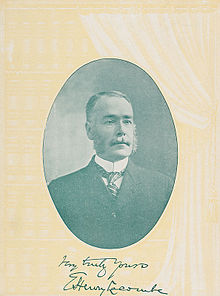Emile Henry Lacombe
Emile Henry Lacombe | |
|---|---|
 | |
| Judge of the United States Court of Appeals for the Second Circuit | |
| In office June 16, 1891 – February 15, 1916 | |
| Appointed by | operation of law |
| Preceded by | Seat established by 26 Stat. 826 |
| Succeeded by | Charles Merrill Hough |
| Judge of the United States Circuit Court for the Second Circuit | |
| In office May 26, 1887 – December 31, 1911 | |
| Appointed by | Grover Cleveland |
| Preceded by | Seat established by 24 Stat. 492 |
| Succeeded by | Seat abolished |
| Personal details | |
| Born | Emile Henry Lacombe January 29, 1846 New York City, New York |
| Died | November 28, 1924 (aged 78) New York City, New York |
| Resting place | Evergreen Cemetery Morristown, New Jersey |
| Education | Columbia University (AB) Columbia Law School (LLB) |
Emile Henry Lacombe (January 29, 1846 – November 28, 1924) was a United States circuit judge of the United States Court of Appeals for the Second Circuit and of the United States Circuit Courts for the Second Circuit.
Education and career
Born on January 29, 1846, in New York City, New York,[1] Lacombe received an Artium Baccalaureus degree in 1863 from Columbia University and a Bachelor of Laws in 1865 from Columbia Law School.[1] He served in the United States Army from 1862 to 1863 during the American Civil War.[1] He entered private practice in New York City from 1865 to 1875.[1] He was assistant corporation counsel for New York City from 1875 to 1884.[1] He was Corporation Counsel for New York City from 1884 to 1887.[1]
Federal judicial service
Lacombe received a
Notable cases
On October 4, 1892, Lacombe ruled that Thomas Edison was the true inventor of the first practical Incandescent Light. Edison's patents; US 223,898 and FR 130,910 claims for invention were novel. Western Electrician, Vol. XI, No.16, October 15, 1892, pp 195-6. In 1893, when Ny Look a Chinese Civil War veteran was arrested for not registering under the Geary Act which required all unregistered Chinese to be arrested and deported, Lacombe ruled in In re Ny Look that there were no deportation provisions in the law and Look could not be detained indefinitely therefore he should be released.[2]
In 1909, Lacombe reluctantly conferred American citizenship on
]The United States Attorney adhered to Lacombe's wishes and took the matter to the Court of Appeals in 1910. The Court of appeal agreed that Parsees belong to the white race and were "as distinct from Hindus as are the English who dwell in India".[3]
Later career and death
Following his retirement from the federal bench, Lacombe resumed private practice in New York City from 1916 to 1924.[1] He served as a Referee in Chancery in New York City in 1919.[1] He died on November 28, 1924, in New York City.[1] He was interred in Evergreen Cemetery in Morristown, New Jersey.[citation needed]
Conspiracy theory
Lacombe wrote a letter to the New York Times advancing a conspiracy theory about the German sinking of the RMS Lusitania in 1915. His letter was published Monday, October 22, 1917, on page 14 titled "A NEW THEORY OF THE LUSITANIA SINKING. The Evidence of the German Medal Dated May 5 and the Report of the Explosive "Cigars" on Board."[4]
References
- ^ a b c d e f g h i j k l m n o Emile Henry Lacombe at the Biographical Directory of Federal Judges, a publication of the Federal Judicial Center.
- ^ "The Ny Look Case," Washington Post, May 28, 1893, p. 4; "The Ny Look Test Case," New York Times, May 26, 1893, p. 4; In re Ny Look, C.C. New York (1893), 56 Fed. 81; “Notes on Recent Decisions,” Minnesota Law Journal vol. 1, no. 4 (August 1893), 86.
- ISBN 978-1-61075-322-7.
- ^ Lacombe, E. Henry (October 22, 1917). "A New Theory of the Lusitania Sinking" (PDF). New York Times. p. 14.
Sources
- Emile Henry Lacombe at the Biographical Directory of Federal Judges, a publication of the Federal Judicial Center.
